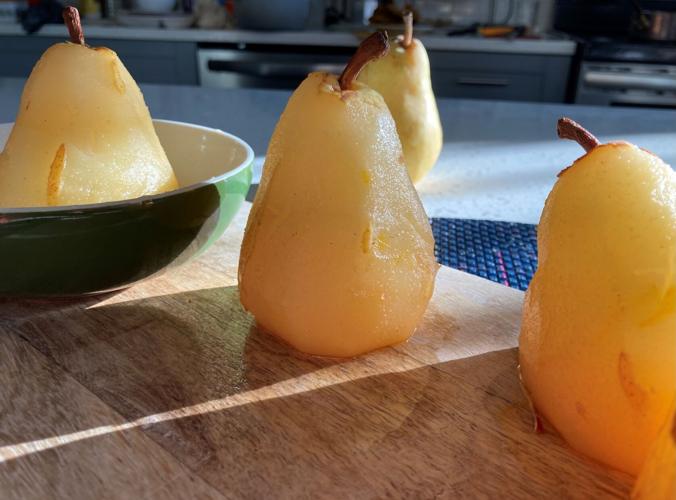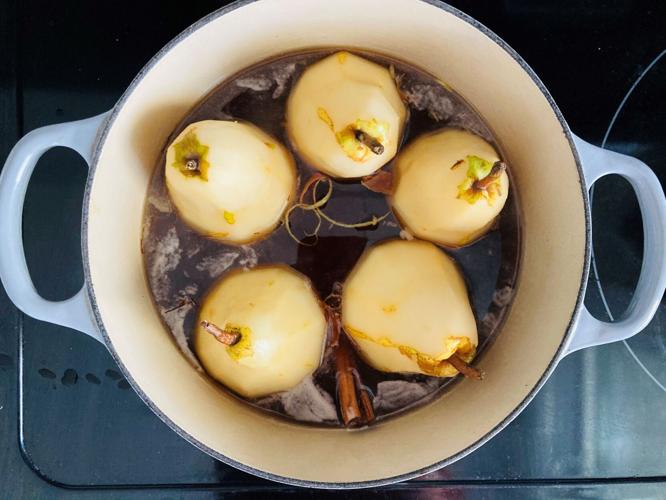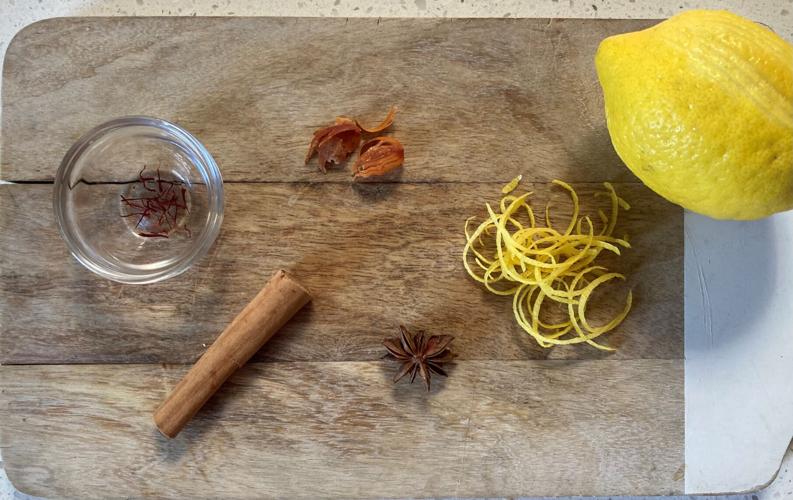Because of COVID, it’s just the two of us for Thanksgiving this year. I am thinking of my mother-in-law, who drove from Kentucky last year to feast with us. I remember asking her what she wanted for the long drive home. Without hesitation, she asked for a few pieces of pie.
The inclination for pie at this time of year runs deep. I get it. I am pro pie, especially for breakfast the morning after when there are dishes still to clean.
Without our mothers or friends at the table as in years past, I am rethinking this year’s menu with plans for fewer sides and a less labor- intensive dessert option. If I want to keep the peace in our quarantined household, I still may need to bake a sweet potato pie. But all this menu editing has had me revisiting an old and simpler favorite: poached pears.
I have long believed that among the pome fruits the pear is woefully underappreciated. As much as I love the crunch and tang of a Pink Lady or Empire apple, I have long wondered why the pear receives a fraction of the autumn fruit limelight, especially given its beguiling floral nectar. You like a baked apple? Then you will love a poached pear.

Bartlett pears in a poaching liquid of black tea, lemon zest and whole spices.
To poach means to gently cook in a seasoned liquid. Gentle cooking over low heat ensures that whatever is being poached stays intact and lets the liquid act as a flavor infuser. Traditionally, pears are poached in wine, but I prefer an alcohol-free medium in the form of brewed tea.
The thing that poached pears have over baked apples, especially at a holiday table, is that they look elegant and graceful after cooking versus wrinkled and homely. The pear’s porous flesh is like a flavor sponge so that when you add cinnamon bark, cardamom seeds or lemon zest to the poaching liquid, you really can taste it. The resulting texture is silky, almost creamy, and tucking in feels downright decadent. But wait, there’s more: Once the pears are done, the poaching liquid keeps on cooking until significantly reduced, transforming into a spiced syrup that is just killer drizzled on top.
Will poached pears make you forget about holiday pie? I doubt it. But they may change your tune about this pome underdog and expand your dessert horizons for holidays to come.

In addition to lemon zest (pictured right), the options for infusing pears are many, including star anise, cinnamon, saffron and mace.
POACHED PEARS WITH SPICED TEA SYRUP
Adapted from “The Meat Lover’s Meatless Celebrations” by Kim O’Donnel.
You can make everything a few days in advance and refrigerate until 30 minutes before serving. Gently reheat the sauce. In recipe development, I used Anjou, Bartlett or Comice varieties and they all translate deliciously.
Ingredients:
- 5 to 6 medium somewhat ripe pears, preferably with stem
- 1 black tea bag of your choice
- 2 1/2 cups water
- 3/4 cup granulated sugar
- Zest of 1 lemon
- Splash of vanilla extract
- Your choice of any or all of the following whole spices: 1 cinnamon stick; 6 cardamom seeds; 1 star anise pod; a few allspice berries
- Pinch of saffron (optional but really nice)
- Optional garnish: 1/4 cup unsalted nuts of choice, chopped finely: pistachios, walnuts, pecans and almonds
Directions:
Place teabag in a cup. Boil 1 cup of the water and pour over the teabag, brewing for 5 minutes. Remove teabag and set tea aside.
Use a pot or saucepan that is at least 9 inches wide. Trace the outline of the pot on parchment paper and cut out the circle. Fold in half and draw a small rainbow (about 1 inch high) and cut along the edges to create a hole in the center. Set parchment aside.
Peel the pears and trim the bottoms so they stand upright. With a paring knife and maybe a small teaspoon, core the pears from the bottom, carefully scraping away the seeds in a screwdriver fashion.
Place the remaining 1 1/2 cups of the water, brewed tea and sugar in the pot. Over medium heat, bring to a quick boil, making sure that the sugar is dissolved. Add the lemon zest and whole spices. Reduce the heat to low and add the pears. They should be able to sit upright, but as they cook, they may wobble on their sides; that’s OK.
Place the prepared parchment circle on top of the pears, which should lay flat. Place a small, heatproof plate on top, then cover the pan.
Over medium-low heat, cook the pears for 15 minutes. Remove the plate and parchment and check for doneness. The pears are done when a paring knife easily glides into their sides. Replace parchment, plate and lid and cook for an additional 10 to 15 minutes as needed. With a slotted spoon, carefully remove the pears and transfer to a plate.
Strain the liquid to capture the whole spices and transfer to a small saucepan. Over medium-high heat, bring liquid to a boil. Cook until the sauce is reduced by more than half, about 30 minutes. The sauce will have the consistency of maple syrup.
Serve the pears at room temperature and sprinkle with chopped nuts, if using. Drizzle sauce over each pear.











